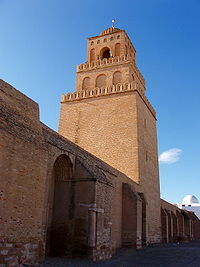- Minaret
-
For the mountain formation, see Minarets (California).
 Crescent on a minaret in Azerbaijan
Crescent on a minaret in Azerbaijan

Part of a series on
Islamic culture
Architecture Arabic · Azeri
Indo-Islamic · Iwan
Moorish · Moroccan · Mughal
Ottoman · Persian · Somali
Sudano-Sahelian · TatarArt Calligraphy · Miniature · Rugs
Dress Abaya · Agal · Boubou
Burqa · Chador · Jellabiya
Niqab · Salwar kameez · Taqiya
kufiya · Thawb · Jilbāb · HijabHolidays Ashura · Arba'een · al-Ghadeer
Chaand Raat · al-Fitr · al-Adha
Imamat Day · al-Kadhim
New Year · Isra and Mi'raj
al-Qadr · Mawlid · Ramadan
Mugam · Mid-Sha'ban
al-TaiyyabLiterature Arabic · Azeri · Bengali
Indonesian · Javanese · Kashmiri
Kurdish · Persian · Punjabi · Sindhi
Somali · South Asian · Turkish · UrduA minaret (Turkish: minare,[1] from Arabic manārah (lighthouse)مناره , sometimes مئذنه) is a distinctive architectural feature of Islamic mosques, generally a tall spire with an onion-shaped or conical crown, usually either free standing or taller than any associated support structure. The basic form of a minaret includes a base, shaft, and gallery. Styles vary regionally and by period. Minarets provide a visual focal point and are used for the call to prayer (adhan).
Contents
Functions
As well as providing a visual cue to a Muslim community, the main function of the minaret is to provide a vantage point from which the call to prayer is made. The call to prayer is issued five times each day: dawn, noon, mid-afternoon, sunset, and night. In most modern mosques, the adhan is called from the musallah, or prayer hall, via microphone to a speaker system on the minaret. Minarets also function as air conditioning mechanisms: as the sun heats the dome, air is drawn in through open windows then up and out of the minaret, thereby providing natural ventilation.[citation needed]
History
 The minaret of the Great Mosque of Kairouan- the oldest standing minaret.[2] City of Kairouan, Tunisia
The minaret of the Great Mosque of Kairouan- the oldest standing minaret.[2] City of Kairouan, Tunisia
The earliest mosques were built without minarets, the call to prayer was performed elsewhere; hadiths relay that the Muslim community of Madina gave the call to prayer from the roof of the house of Muhammad, which doubled as a place for prayer. Around 80 years after Muhammad's death the first known minarets appeared.[3]
Minarets have been described as the "gate from heaven and earth", and as the Arabic language letter alif (which is a straight vertical line).[4]
The massive minaret of the Great Mosque of Kairouan in Tunisia is the oldest standing minaret.[2][5] Its construction began during the first third of the 8th century and was completed in 836 CE.[6] The imposing square-plan tower consists of three sections of decreasing size reaching 31.5 meters.[6] Considered as the prototype for minarets of the western Islamic world, it served as a model for many later minarets.[6] Despite the austerity of its decoration, the minaret of the Great Mosque of Kairouan stands out by its harmonious appearance and striking majesty.[6]
The tallest minaret, at 210 metres (689 ft.) is located at the Hassan II Mosque in Casablanca, Morocco The tallest brick minaret is Qutub Minar located in Delhi, India.[7]
In some of the oldest mosques, such as the Great Mosque of Damascus, minarets originally served as illuminated watchtowers (hence the derivation of the word from the Arabic nur, meaning "light").[citation needed]
Construction
Minarets basic form consist of three parts: a base, shaft, and a gallery. For the base, the ground is excavated until a hard foundation is reached. Gravel and other supporting materials may be used as a foundation; it is unusual for the minaret to be built directly upon ground-level soil. Minarets may be conical (tapering), square, cylindrical, or polygonal (faceted). Stairs circle the shaft in a counter-clockwise fashion, providing necessary structural support to the highly elongated shaft. The gallery is a balcony which encircles the upper sections from which the muezzin may give the call to prayer. It is covered by a roof-like canopy and adorned with ornamentation, such as decorative brick and tile work, cornices, arches and inscriptions, with the transition from the shaft to the gallery typically sporting muqarnas. Originally plain in style, a minaret's origin in time can be determined by its level of ostentation.[citation needed]
Local styles
Styles and architecture can vary widely according to region and time period. Here are a few styles and the localities from which they derive:
- Tunisia
- (7th century) Quadrangular, the Mosque of Uqba of kairouan have the oldest Minaret in the Muslim world.
- Turkish (11th century)
- 1, 2, 4 or 6 minarets related to the size of the mosque. Slim, circular minarets of equal cross-section are common.
- Egypt (7th century) / Syria (until 13th century)
- Low square towers sitting at the four corners of the mosque.
- Iraq
- For a free-standing conical minaret surrounded by a spiral staircase, see Malwiya.
- Egypt (15th century)
- Octagonal. Two balconies, the upper smaller than the lower, projecting mukarnas, surmounted by an elongated finial.
- Persia (17th century)
- Generally two pairs of slim, blue tile clad towers flanking the mosque entrance, terminating in covered balconies.
- Tatar (18th century)
- Tatar mosque:A sole minaret is used, placed at the centre of a gabled roof.
- Morocco
- Typically a single square minaret. Notable exceptions are the octagonal minaret located in Chefchaouen and the round minaret located in Moulay Idriss.
- South Asia
- Octagonal, generally three balconied, with the upper most roofed by an onion dome and topped by a small finial.
Examples
-
Baitul Futuh Mosque minaret in London, United Kingdom.
-
Islamic-Specific Architecture in a Mosque with Two Minarets in Nishapur
-
Minaret in Wangen bei Olten, Switzerland.
-
Faisal Mosque Minaret, Islamabad, Pakistan
-
The Charminar in Hyderabad, India
-
The four Minerats in Quba Mosque, the first mosque in history built by Prophet Muhammad upon arrival in Madinah, Saudi Arabia
-
The six minareted Blue Mosque or Sultan Ahmed Mosque in Istanbul, Turkey.
-
Majapahit-style minaret of Menara Kudus Mosque in Java, Indonesia
-
The minaret of the Wazir Khan Mosque in Lahore, Pakistan
-
One of the minarets of the Badshahi Mosque also in Lahore, Pakistan
-
Simple wooden pole used as minaret in Nouadhibou, Mauritania
-
Wooden minaret of the Dungan Mosque in Karakol, Kyrgyzstan
-
Sabah State Mosque minaret in Kota Kinabalu, Malaysia (Borneo).
-
Minaret at mosque in Riyadh, Saudi Arabia.
-
The White Minaret in Qadian, India.
-
The 74m Minerat of the Grand Mosque in Kuwait City, Kuwait
-
The Minerat in the Mosque of the Prophet Muhammad in Madinah,Saudi Arabia
-
The "bare tower" of Huaisheng Mosque, Guangzhou, China
-
A Burmese-style mosque with an elaborately carved minaret in Amarapura
-
Minaret in Kashgar, China.
-
Chinguetti mosque minaret, in Mauritania
-
The four minarets in Mashkhur Jusup central mosque, Pavlodar , Kazakhstan.
-
A Minaret of a Mosque in central Jubail, Saudi Arabia.
-
Minaret of Al Othman Mosque in Jebla, Kuwait; build in 1857.
-
The Ghawanima Minaret, 1900; one of the four minarets of Al-Aqsa Mosque, Old City Jerusalem
See also
References
- ^ "minaret." Online Etymology Dictionary. Douglas Harper, Historian. 21 Mar. 2009.
- ^ a b Titus Burckhardt, Art of Islam, Language and Meaning: Commemorative Edition. World Wisdom. 2009. p. 128
- ^ Paul Johnson, Civilizations of the Holy Land. Weidenfeld and Nicolson, 1979, p. 173
- ^ University of London, Bulletin of the School of Oriental and African Studies, University of London, Volume 68. The School. 2005. p. 26
- ^ Linda Kay Davidson and David Martin Gitlitz, Pilgrimage: from the Ganges to Graceland : an encyclopedia, Volume 1. ABC-CLIO. 2002. p. 302
- ^ a b c d Minaret of the Great Mosque of Kairouan (Qantara Mediterranean Heritage)
- ^ Jamal Malik, Islam in South Asia: a short history, BRILL, 2008, page 424
External links
Categories:- Islamic architectural elements
- Arabic loanwords
- Islamic architecture
- Mosque architecture
- Architectural elements
- Arabic words and phrases
- Arabic architecture
Wikimedia Foundation. 2010.






























